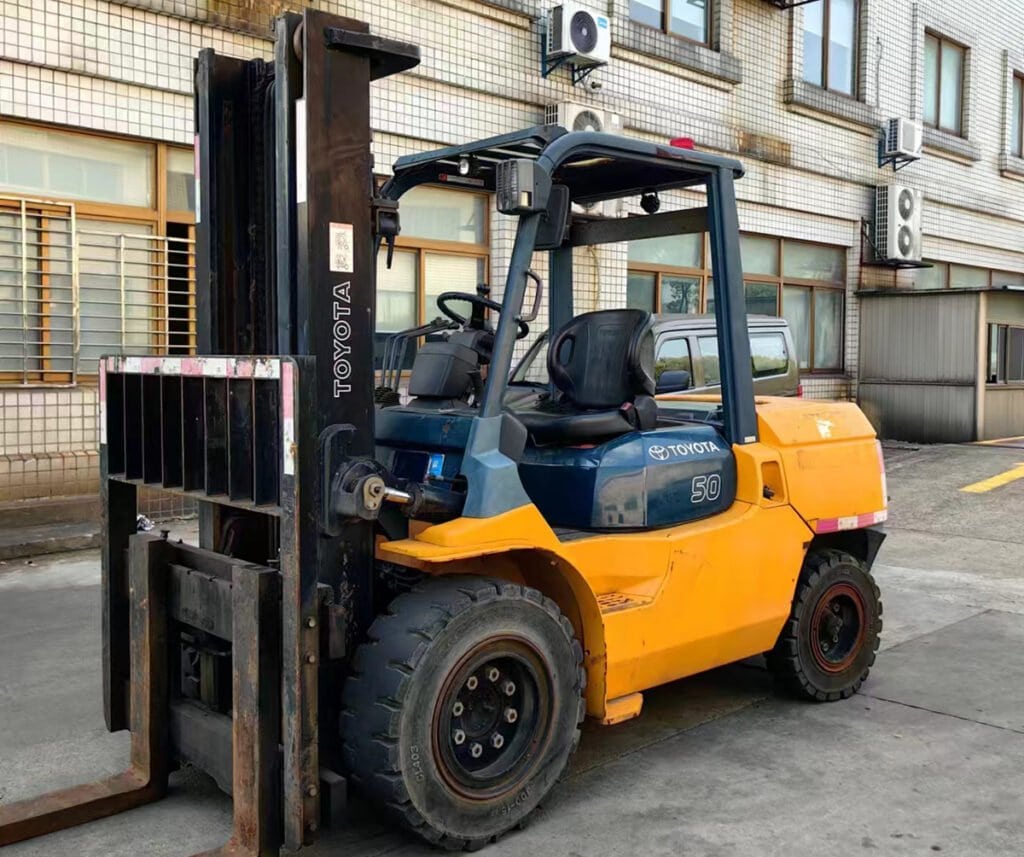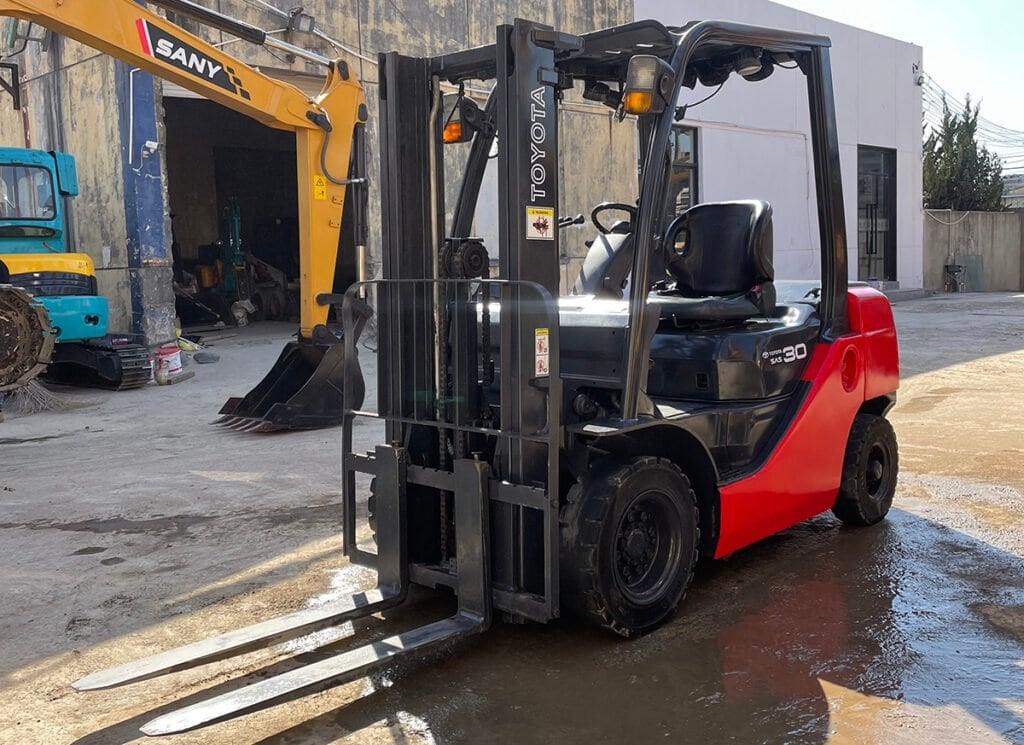When you’re running a business that relies on efficient material handling, the choice of equipment can make a big difference in productivity and safety. A used forklift can be a cost-effective solution, offering reliable performance at a fraction of the price of a new model.
However, to choose the right used forklift for your operation requires careful consideration of factors such as the type of forklift, its condition, load capacity, environment compatibility, and maintenance history.
This guide will help you navigate each of these elements to make a smart purchase.

1. Understand Your Operational Needs
Overview: Start by evaluating your specific operational needs. The type of forklift you need largely depends on your industry, the nature of your goods, and the characteristics of your workspace. Clearly defining your requirements will narrow down your options and help you focus on forklifts that best align with your business needs.
Key Considerations:
- Load Weight and Height Requirements: Determine the maximum weight you need to lift and the highest point to which you need to raise loads. Forklifts come with varied lifting capacities, and to choose the right used forklift capacity is essential to prevent accidents and equipment strain.
- Frequency of Use: If you need a forklift for daily, heavy-duty operations, it’s crucial to select a model known for durability. For occasional use, a lower-duty forklift may suffice, potentially saving you money.
- Maneuverability Requirements: Think about the layout of your facility. If you’re working in a confined space or navigating narrow aisles, a compact or narrow-aisle forklift may be ideal.
Understanding these operational needs will ensure that the forklift you select is equipped to handle the workload efficiently and safely.
2. Choose the Right مستخدم Forklift Type
Overview: Forklifts come in various types, each designed to suit specific applications and environments. By selecting the correct forklift type, you can enhance productivity, reduce operational costs, and ensure worker safety.
Common Forklift Types:
- Counterbalance Forklifts: These are the most versatile and widely used. Ideal for warehouse operations, they have forks extending from the front, balancing the weight of the load at the rear. They’re suitable for a variety of indoor tasks.
- Reach Trucks: Best for warehouses with high shelving, reach trucks are designed to extend forward and lift loads to great heights, making them ideal for confined spaces and indoor environments.
- Rough Terrain Forklifts: If you’re working outdoors on uneven surfaces, rough terrain forklifts with large, pneumatic tires provide stability and traction, making them suitable for construction sites or lumber yards.
- Pallet Jacks and Walkie Stackers: For lower-capacity tasks or quick material handling jobs, these smaller, often manually-operated options are useful in light-duty environments or tight spaces.
Matching the type of forklift to your specific needs will allow for more efficient and safer operations.

3. Assess the Forklift’s Condition and Age
Overview: When buying a used forklift, it’s crucial to assess its condition and age. These factors directly impact the machine’s reliability, performance, and remaining lifespan. Examining a forklift’s physical and mechanical state will help you identify potential issues and estimate future maintenance needs.
Condition and Age Checklist:
- Engine and Transmission: Check for unusual noises, smoke, or vibrations during operation. A well-maintained engine should start smoothly and operate quietly. Transmission issues, like delayed gear shifts, can indicate internal problems.
- النظام الهيدروليكي: Inspect hydraulic hoses and cylinders for leaks, wear, or damage. Hydraulic problems can affect lifting capabilities and require costly repairs if ignored.
- Mast, Forks, and Carriage: Inspect the mast for smooth lifting and lowering actions. Examine the forks for signs of bending or cracks, as damaged forks can compromise safety.
- Odometer and Hour Meter: While mileage isn’t as important for forklifts as operational hours, a lower hour meter typically indicates less wear and tear. Keep in mind that forklifts with extremely high operational hours may require more frequent maintenance.
- Battery Condition (for Electric Forklifts): In electric models, battery health is a crucial factor. Make sure the battery holds a charge effectively and inspect it for corrosion or damage.
To choose the right used forklift in good condition will minimize downtime and unexpected repair costs, allowing for a more reliable and consistent performance.
4. Consider Load Capacity and Stability
Overview: Load capacity is a fundamental factor when you want to choose the right used forklift. Forklifts come in a range of load capacities, so it’s essential to match the capacity of the machine with your maximum load requirements. Ensuring stability and safe lifting capacities will prevent accidents and prolong the life of your forklift.
Load Capacity Considerations:
- Maximum Load Weight: Identify the heaviest load the forklift needs to handle. It’s advisable to select a forklift with a capacity that exceeds your maximum weight needs slightly, providing a buffer for safety.
- Load Center: Understand the forklift’s load center, which is the point at which the load’s weight is centered. A higher load center requires more capacity and can impact stability. Check the forklift’s specifications to ensure it can handle your load configurations.
- Height and Load Stability: When lifting to higher shelves or storage areas, be mindful of the forklift’s stability at maximum lift height. A forklift may be capable of lifting heavy loads but can become unstable at greater heights.
To choose the right used forklift with the correct load capacity and stability features will improve safety and productivity on-site, reducing the risk of tipping and mechanical strain.

5. Inspect for Safety Features
Overview: Safety is paramount when operating heavy machinery like forklifts. By ensuring that the forklift is equipped with appropriate safety features, you can reduce accident risks, protect employees, and comply with safety regulations.
Key Safety Features:
- Overhead Guard: Protects the operator from falling objects, particularly useful in environments where items are stored on high shelves.
- Seat Belt and Restraint System: A functional seat belt is essential for keeping the operator secure, especially during sudden stops or on uneven terrain.
- Visibility Enhancements: Look for clear mirrors, adequate lighting, and backup alarms. These features help operators navigate safely, especially in low-visibility environments.
- Braking System: Inspect brakes to ensure quick response and reliability. Well-maintained brakes are essential for preventing accidents, particularly in high-traffic areas.
- Anti-Tip and Stability Controls: Many modern forklifts come with stability features that reduce the likelihood of tipping, making them safer for high-lift applications.
Selecting a forklift with robust safety features not only protects your team but can also enhance overall productivity by preventing costly accidents and downtime.
6. Evaluate the Maintenance History
Overview: A detailed maintenance history provides insight into the forklift’s care, frequency of use, and any previous issues. A well-documented service record often indicates reliable performance, whereas gaps in maintenance could signal neglected repairs or underlying problems.
Key Points to Review in Maintenance Records:
- Routine Maintenance: Check for regular maintenance activities, such as oil changes, filter replacements, and battery checks. Consistent maintenance suggests the forklift was well cared for and may perform reliably.
- Major Repairs or Part Replacements: Look for any significant repairs or part replacements. If essential components, like the transmission or hydraulic system, have been replaced, it could indicate heavy past usage but also recent improvements.
- Unresolved Issues: Note any recurring problems that haven’t been addressed. These can be red flags and may result in costly repairs down the line.
- Service Intervals: Forklifts that are serviced at manufacturer-recommended intervals tend to have longer lifespans and fewer operational issues. Machines with irregular service intervals may have experienced more wear and tear.
Evaluating the maintenance history helps you make an informed decision, providing peace of mind that the forklift has been properly cared for.

7. Consider Fuel Type and Environmental Impact
Overview: Forklifts operate on different fuel types—diesel, gasoline, LPG, or electric—each with unique benefits and limitations. The fuel type you select impacts operational costs, environmental impact, and suitability for specific work environments.
Fuel Type Considerations:
- Diesel Forklifts: Known for power and endurance, diesel forklifts are suitable for heavy lifting and outdoor use. However, they produce emissions that make them less ideal for indoor environments.
- Gasoline and LPG Forklifts: These models offer versatility and are often cheaper than diesel models. LPG forklifts produce fewer emissions than gasoline or diesel, making them a viable option for semi-enclosed spaces.
- Electric Forklifts: Emission-free and quieter, electric forklifts are well-suited for indoor operations. They are energy-efficient but require charging infrastructure and may have limitations in extended, high-intensity applications.
- Hybrid Options: Some forklifts come with hybrid power options, combining electric and internal combustion for greater flexibility across environments.
To choose the right used forklift fuel type can reduce operational costs and improve your forklift’s adaptability to your workspace and environmental standards.

خاتمة
To choose the right used forklift for your operation involves a comprehensive understanding of your needs, the forklift’s specifications, and key operational factors. By taking the time to evaluate load capacity, safety features, fuel type, and maintenance history, you can find a used forklift that meets your performance expectations and aligns with your budget. Making an informed choice helps you avoid costly repairs and ensures the forklift you select can handle your workload efficiently and safely.